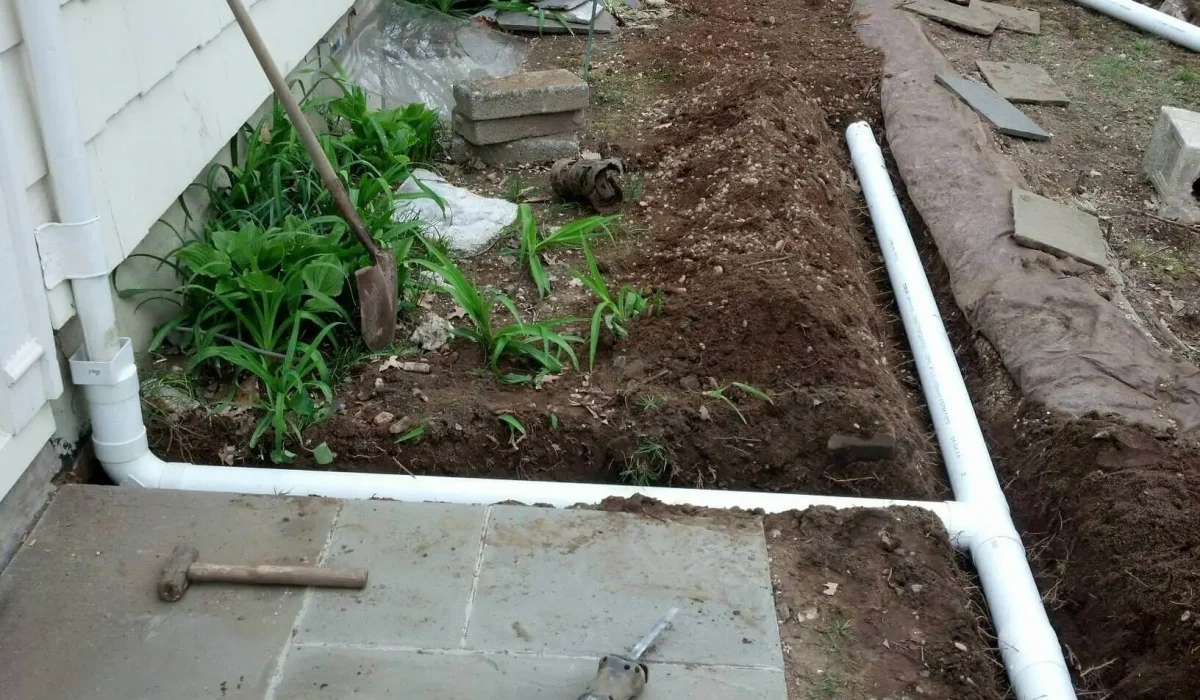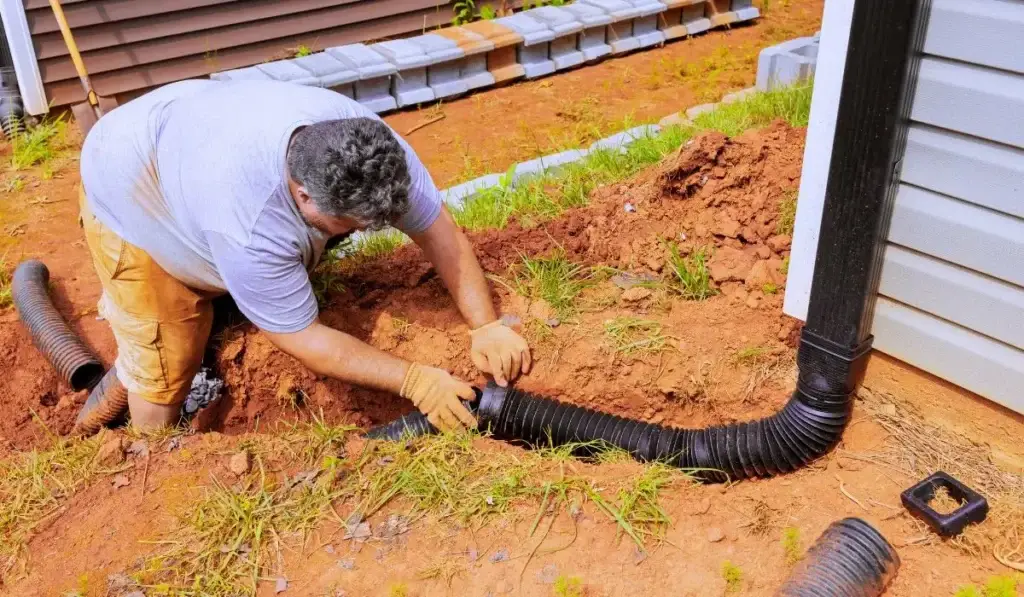Common Underground Gutter Drains Issues Homeowners Often Overlook
Standing water near the foundation, soggy landscaping, or a musty basement can all point to a serious problem with underground gutter drains—an issue many homeowners overlook until damage is already underway. Functional gutters and surface drains are only half the equation. What lies beneath your lawn can make or break your home’s ability to handle rain and melting snow.
Homeowners throughout the western suburbs rely on Gutter Medics, a trusted provider of gutter cleaning, repair, and installation services, to ensure both above-ground and underground systems work in sync to protect their properties.
Protect your foundation before problems begin. Gutter Medics offers expert underground drainage inspections and repairs across Chicagoland.
How Underground Gutter Drains Works?
Understanding how these below-ground systems function is the first step in spotting problems early. If water isn’t flowing properly through your underground pipes, damage can build up fast—often without any visible surface signs.
Connecting Downspouts to Subsurface Pipes
Most homes route water from the downspouts into a series of underground drainage pipes that carry the runoff safely away from the foundation. These pipes are often made of corrugated plastic or PVC and are buried 6 to 18 inches below ground. They’re sloped to use gravity for water movement, directing water to a discharge point like a pop-up emitter, dry well, or curb.
One of the most frequent issues we see stems from poor slope angles. Water needs a minimum slope of 1%—roughly 1 inch of fall per 8 feet of pipe—to maintain adequate flow. Anything less, and water starts to stagnate, leading to sediment buildup and pipe degradation.
For homeowners in the western suburbs, this local gutter cleaning service in Downers Grove is a trusted choice for seasonal upkeep and prevention.
💡 Helpful Tip: If your home was built before the 1990s, it’s worth checking whether your underground pipes meet this slope standard. Many older homes used flatter pitches that cause drainage problems today.
Redirecting Water Away from the Foundation
A properly installed underground gutter drain system ensures that water doesn’t settle around the foundation. Without this system, hydrostatic pressure builds in the soil, pushing water against your home’s concrete walls. Over time, this can lead to cracks, basement leaks, and even structural shifts.
Building codes in many U.S. municipalities now recommend that runoff be discharged at least 10 feet from the foundation. However, older homes may only push water a few feet away, increasing the risk of reabsorption and damage.
The Most Common Reasons Underground Drains Fail
Underground drainage systems can break down for several reasons. Recognizing the causes can help you stay ahead of damage and avoid costly repairs.
1️⃣ Tree Root Intrusion
Roots from nearby trees or shrubs can breach even small cracks in underground pipes. Once inside, roots expand and trap debris, eventually forming a full blockage. In some cases, root intrusion goes unnoticed until heavy rainfall causes water to back up into downspouts or overflow near the home.
Drain cameras often reveal tangled root masses inside failed pipes, especially in systems older than 15 years. Homeowners searching for underground gutter drain repair near me are frequently dealing with this exact issue.
💡 Helpful Tip: Avoid planting trees or large shrubs within 10 feet of your gutter drainage paths. Choose deep-root plants instead of shallow-root ones near underground systems.
2️⃣ Pipe Collapses or Shifting Soil
Soil conditions vary dramatically in Chicagoland. Clay soils expand when wet and contract during dry spells, putting pressure on buried pipes. Freeze-thaw cycles can also push pipes upward or crush them from above. Poor compaction during installation is another culprit—when the trench isn’t properly filled, pipes can sag or collapse under the weight of the soil and foot traffic.
A collapsed pipe doesn’t always leak; it can become a hidden trap for debris and water. That’s why early diagnosis through inspection is key.
A more detailed explanation of underground drainage challenges, system components, and solutions is available in this helpful homeowner resource: Underground Drainage Systems – A Homeowner’s Guide.
3️⃣ Buildup from Leaves, Sediment, and Ice
Even the best-designed systems need regular maintenance. Leaves, twigs, shingle grit, and dirt gradually accumulate inside underground lines. Unlike open gutters, these clogs are invisible—until problems surface.
In winter, standing water in clogged pipes can freeze solid, splitting the pipe and leading to costly repairs. That’s why it’s essential to unclog gutter drain underground systems before cold weather sets in.
💡 Helpful Tip: If you live in an area with heavy leaf fall or snow, schedule a drain cleaning every 12 months—ideally in late fall, before the first freeze.

Warning Signs You Need Drain Repair
It’s not always obvious when something is wrong underground. These warning signs indicate it’s time to investigate your system and possibly schedule underground gutter drain cleaning.
Water Pooling in the Yard or Near the Home
If water lingers near your home after rain, it’s a red flag. This not only drowns your grass and flowers but increases the risk of moisture seeping into your basement or crawlspace.
Look for depressions in the yard or areas where mulch constantly shifts or washes away. These are surface-level indicators of deeper issues.
Overflowing Downspouts During Rain
Your downspouts should quietly channel water away. If they gush violently or splash water back onto the siding, the underground system is likely blocked. Even if surface gutters are clean, the blockage may exist deeper in the line—prompting the need for underground gutter drain cleaning.
💡 Helpful Tip: Stand near your downspouts during the next rain. If you hear gurgling or splashing, it’s time for a drain inspection.
Persistent Basement Moisture
Even small amounts of moisture in the basement can create serious problems over time. A musty smell, damp walls, or water stains are early signs that something is wrong with your drainage system. Often, these issues begin underground—where clogged or damaged gutter drains push water back toward your foundation.
Mold can begin growing within 24 to 48 hours of water exposure if moisture is not properly controlled, according to the U.S. Environmental Protection Agency. A wet basement not only damages materials—it can contribute to poor indoor air quality, respiratory irritation, and other health risks.
💡 Helpful Tip: If your basement feels humid after a storm, or you notice dampness in corners, it’s time to inspect your drainage system—especially the underground components.
Gutter Medics' Process for Diagnosing & Fixing Underground Gutter Drains
Gutter Medics, specialize in identifying and resolving underground drainage problems. Our solutions are designed to minimize disruption while maximizing long-term effectiveness.
🔹 Camera Inspections and Flow Testing
We use high-resolution cameras to inspect the interior of your drain lines. These flexible cameras travel through underground pipes, identifying blockages, root intrusion, or pipe separation without disturbing your yard.
We follow this with a flow test—introducing water into the system and watching how it moves. This dual approach ensures we find both the location and the cause of the failure.
🔹 Excavation-Free Repair Options
In many cases, we can clear obstructions using trenchless methods like hydro-jetting or mechanical augers. These tools unclog gutter drain underground systems quickly and restore full function—no digging required.
Hydro-jetting uses high-pressure water to remove buildup without damaging the pipe walls, while augers can cut through tough root masses or frozen debris.
🔹 Pipe Rerouting and Drain Flushing
Some homes are better served by rerouting old systems, especially if the original layout doesn’t comply with modern standards or is too damaged to salvage. In these cases, we flush debris from the system, install new piping where necessary, and update the slope for optimal drainage performance.
You’ll receive a complete map of your updated drainage layout for future maintenance and inspection.
Don’t wait for costly water damage to show up.
How to Prevent Future Underground Gutter Drain Failures?
Prevention is always better than repair. A few smart maintenance steps can keep your underground gutter drains working for years to come.
Yearly Inspections and Cleaning
A single spring or fall cleaning can prevent most clogs. Our team recommends an annual service to flush debris, check flow rates, and inspect for early warning signs.
Many Chicagoland homeowners now schedule proactive visits instead of waiting for issues. This minimizes emergency costs and extends the life of your system.
Debris Guards at Entry Points
Installing leaf traps or strainers at the connection point between the downspout and the underground gutter drain is an effective preventative measure. These devices catch leaves and larger debris before they enter the pipe, reducing the frequency of cleaning and the risk of blockage.
Drainage System Mapping for Easy Maintenance
During installation or repair, our team can create a digital map of your system showing pipe locations, cleanouts, and discharge points. This makes it easier to troubleshoot future issues and helps homeowners avoid unintentional damage during landscaping projects.
Homeowners throughout Chicagoland consistently turn to Gutter Medics for dependable service backed by over 20 years of hands-on experience. From gutter cleaning, repair, and installation to advanced underground drainage system care, every solution is delivered by trained, in-house technicians—not subcontractors.
Avoid hidden damage from underground drain failures. Schedule a professional inspection with Gutter Medics today by calling (630) 922-3131. Your underground gutter drains deserve expert care, and we’re ready to deliver it.
Frequently Asked Questions
You should aim to clean your gutters at least twice a year. Depending on the type of foliage near your home (for example, pine trees), you may want to clean once every three months.
Most experts agree the best time of year to clean your gutters is in the spring and fall. An early spring cleaning will help clear out all the leaves and debris from your gutters and ensure rainfall can flow freely into the spouts.
Gutter cleaning removes debris, dirt, and leaves from your gutters and downspouts, which clog your gutter system and prevent rainwater from flowing freely from the roof to the ground. Professionals may scoop the debris by hand or by machine.
When you don’t clean your gutters, the downspouts can become clogged with leaves, debris, or other debris. This blockage causes standing water to accumulate and eventually overflow. Leaves that clog your gutter can begin to decompose and eventually rot if left unattended.
A typical 2,000-square-foot home on a roof maintenance program where gutters are cleaned once a year should take 30 to 45 minutes, depending on how dirty they are. Unmaintained gutters can take up to an hour and a half to clean.

